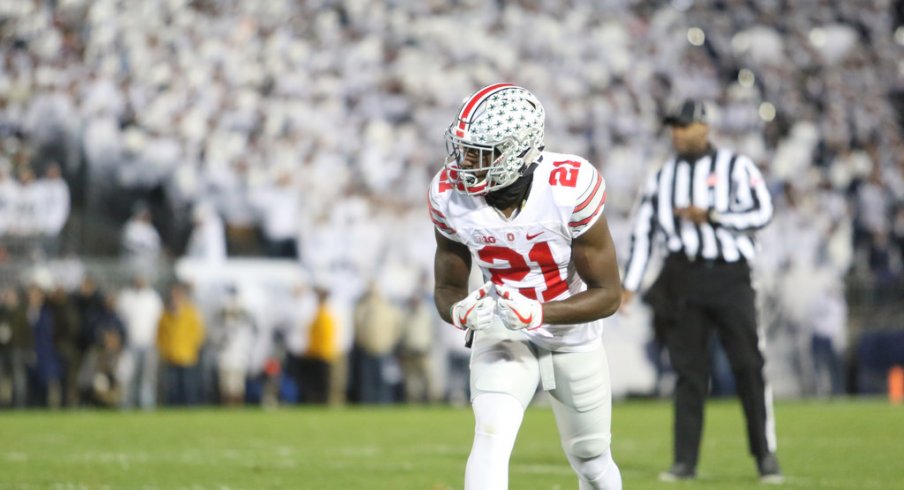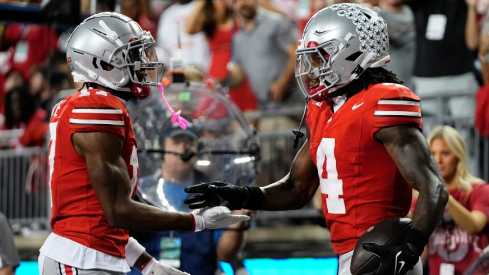In many ways, the Buckeyes followed a common recipe for a hard-fought victory on the road Saturday night in State College.
They took care of the ball and didn't commit a single turnover, despite the wet and windy conditions. They out-gained their opponents by a margin of 137 yards. The offense's star player, Curtis Samuel, tallied 139 all-purpose yards while the defense held Penn State to -7 yards of offense for the entire third quarter.
While two special teams miscues ultimately powered the Nittany Lions to the upset victory, the Buckeyes had multiple opportunities to put away their conference rival and a blocked field goal should have never been the difference between a win and a loss. Yet despite leading for the vast majority of the contest, Ohio State left multiple plays on the field thanks to an offense that looked out of sync for the third consecutive week.
Though Urban Meyer has always focused primarily on running the football to set up the downfield passing game, his team has had a great deal of trouble creating those big plays through the air this fall. Since the departure of Devin Smith to the NFL following the 2014 season, the Buckeyes have failed to find a reliable deep threat that can beat defenders one-on-one and force the secondary to adjust accordingly to this threat.
Entering the season, many close to the program believed Samuel and Noah Brown would fill the roles of underneath receiver and red-zone threat respectively, and the duo has largely lived up to the billing. However, without a deep threat to join those two on the field, the result has been a largely non-existent mid-range passing game as opponents have gone back to the aggressive tactics that often rattled OSU receivers in 2012 and 2013.
In a hostile environment for the second straight week, the issues with the Buckeye passing game came to head. As Kirk Herbstreit noted during the TV broadcast, Meyer and his staff were largely depending on quarterback J.T. Barrett to manufacture big plays through improvisation rather than rely on the game plan to pick up yards when throwing the ball.
Many fans have criticized the play-calling, while some have gone as far as to call for Barrett's benching since the Buckeyes exited Beaver Stadium late Saturday night. But in reality, many hands can be blamed for the offensive problems we've witnessed during the month of October.
The issues began early in the evening, as the Buckeyes looked to punch in a touchdown on their third possession. After taking the snap from the PSU 20-yard line, Barrett appeared to simply overthrow a wide-open Samuel on a corner route.
Knowing Penn State would be in zone coverage, the call from coordinator Ed Warinner was perfect, as Samuel should have walked into the end zone with no defender near him. However, Campbell was unable to get away from the contact initiated by the Penn State cornerback, and while many will argue the play warranted a holding penalty on the defense, the receiver's job is not to draw a flag in this situation. Campbell allowed the defender jam him with both hands instead of simply running right by, which was his only job on the play.
Luckily, Campbell seemed to learn from his mistake as he helped clear out a lane for Marcus Baugh's touchdown later in the half, but the damage had already been done. The Buckeyes had to settle for a field goal instead of netting 6 points on this first quarter drive, a difference of four potential points in a game ultimately decided by three.
On the very next drive, another young receiver would commit a similar blunder. This time, Terry McLaurin ran the corner route in the same 'Sail' concept run in the example above, but couldn't get away from his defender for the same reason as Campbell.
Though he eventually gained outside position on the route, signaling that Barrett should get him the ball, the contact off the line forced McLaurin to stumble on his cut while allowing the defender to make up ground and knock down the pass. Much the same way a pass rusher uses his hands to fight off the block of an offensive linemen, receivers must rip through to keep the defender from getting their hands on them off the line of scrimmage, a technique that former Buckeye Michael Thomas seemed to master.
But the problems with the OSU receiving corps aren't just limited to facing physical coverage. On the rare occasions that Barrett did look downfield with the ball, his targets weren't doing their part to separate from the defense.
James Clark attacks hard upfield against the defender in this instance but does little to try and turn the defender out of position. While Clark does...something...with his arms, there is no head fake or hard step to the outside to force the defender to open his hips in the wrong direction, or even stutter as he blankets the receiver. Though many will argue that this group of young wideouts needs more opportunities to get involved, Buckeye wide receivers not named Samuel or Brown made up only four of Barrett's career-high 28 completions against Penn State.
The easy response is to replace these underperforming wideouts with highly touted recruits like Austin Mack or Binjimen Victor. But if the coaching staff hasn't been able to teach simple route-running techniques to guys like Campbell or Clark that have been in the program for years, there's no reason to think those techniques will have been instilled in young guys that have only been there for a matter of months.
The response to this underperformance from this position group has been to play Curtis Samuel more as a traditional slot receiver than we saw from him in September. While Samuel may be the most explosive runner from the backfield, as his 74-yard TD run in the second half showed, he's also been the most dependable route-runner on the team.
Samuel is filling a role once played by former Buckeye and current Carolina Panther Corey 'Philly' Brown, who caught 123 passes during Meyer's first two seasons in Columbus and acted as Braxton Miller's primary target. The 'H-Option' concept that consistently sprung Brown was called countless times last weekend in Happy Valley and was responsible for a number of Samuel's eight catches.
But as we can see in this example, Barrett was pressured in the pocket and managed to move forward while keeping his eyes downfield and deliver a throw just in time. The OSU quarterback seemed to find himself in this situation all night, the result of a young offensive line that seemed to finally play like a unit featuring three new starters.
Barrett was pressured a staggering 34 times in 49 dropbacks, thanks in large part to the trio of Isaiah Prince, Michael Jordan, and Jamarco Jones. All three had played fairly well in their first six games, but the Penn State defensive front turned each in turnstiles on this evening, and the Buckeye aerial attack suffered as a result.
All that said, there is still hope for Barrett and the Ohio State passing game. Late in the fourth quarter, we saw Noah Brown convert the longest gain of the night through the air thanks to a deep crossing route that was far different from the slants and hitches we're used to seeing from him.
While Brown doesn't have the pure speed to separate vertically, that trait isn't necessary to find the soft spot behind the linebackers and fill the void left by the safety following a receiver downfield. Crossing concepts like this one, Drive, and Mesh would all be welcome additions to future game plans as they all allow the young Buckeye receivers to attack horizontally instead of running the vertical routes that have failed to break open in recent weeks.
Most importantly, the Buckeyes still have Barrett, who is on pace to match nearly every passing metric from his record-breaking 2014 campaign. The Junior has 17 touchdown passes and only four interceptions while completing 63% of his passes through seven games. The only stat that is down from his award-winning season two years ago is his yards-per-attempt, which can be attributed directly to his lack of a deep threat.
Had it not been for Barrett, the Buckeyes would've been in much deeper trouble in State College, as his scrambling ability and downfield vision kept his team in the lead for longer than it probably deserved. Despite 15 incompletions and six sacks on those 34 pressures, the Buckeye QB still kept 13 plays alive all by himself.
Many of those 13 scrambles came on the impressive nine third-downs Ohio State managed to convert that night, but such a formula is not sustainable in the long term. With little fear of the passing game, Penn State attacked on early downs with blitzes to shut down the running game, limiting OSU to a paltry 3.38 yards-per-play on first downs and providing a recipe to upcoming opponents.
When the Buckeyes take on Northwestern, Nebraska, Maryland, and Michigan State over the next month, they'll have a chance to work out the kinks against the 111th, 55th, 13th, and 64th ranked defenses against the pass respectively. But while Meyer, Barrett, and the rest of the team are still able to control their own destiny, the season-ending matchup with Michigan and the top pass defense in the nation now looms larger than ever.



